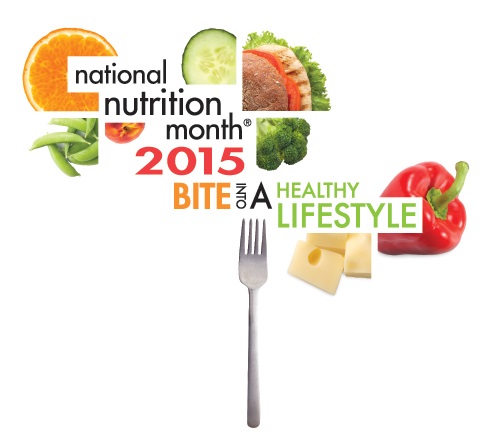Good Health Focus with National Nutrition Month!
With this year’s National Nutrition Month challenging Americans to embrace a balanced, healthful lifestyle, professional chefs and restaurateurs are finding they can take a more active role in helping customers modify their eating habits.
The theme of this year’s month-long event, “Bite into a Healthy Lifestyle,” emphasizes the message that there is no single “food, drink, pill or machine” that will lead to a more healthful way to live. The Academy of Nutrition and Dietetics, which is sponsoring the March event for the 32nd year, advises Americans to take a more holistic approach by consuming fewer calories, making informed food choices, maintaining a healthy weight and exercising daily.
“A healthy lifestyle — one based on regular physical activity and an eating pattern chosen to meet individual needs within calorie limits — is vital to maintaining good health and quality of life,” says Academy president Sonja Connor.
Meanwhile, many professional culinarians and foodservice operators are seeking new ways to accommodate Americans’ evolving, health-centric dining habits. According to the National Restaurant Association’s 2015 Culinary Forecast, good nutrition factored among the Top 20 Food Trends while interest in other elements such as smaller portions, whole grains, natural ingredients and minimally processed food, vegetarian dishes and mini desserts also were top of mind for the 1,300 chefs polled for the recent study.
“Chefs and restaurateurs can play a huge role in this,” says Sara Haas, a Chicago-based culinary dietitian and spokesperson for the Academy of Nutrition and Dietetics. When it comes to food preparation outside of the home, professionals can expand their influence on how healthfully people eat, she says, adding, “They can help their communities. They can get on board with preparing food in a more healthful fashion.”
Haas points to a number of ways chefs and restaurateurs can accommodate customers who want to adopt more healthful lifestyles. One tip she offers is to focus less on protein as a center-of-the-plate item. “Think about the whole plate,” she says. “Build a plate that also includes vegetables, whole grains and legumes. Add more elements. You don’t need to offer quite so much protein if you balance things better on the plate.”
Another way of reducing protein, some experts say, is by mixing ground meat like beef or turkey with whole grains or chopped mushrooms. Not only does this mashup add flavor and moisture to the dish, but it adds volume as well.
Whole-grain flour can ramp up the nutritional value of many baked goods as well.
Haas also advocates making vegetables more attractive and creatively presented. “Turn a turnip into something amazing,” she says. “Offer it as a puree. I’m a big fan of anyone who can take a vegetable and present it with great color and flavor.”
She also challenges chefs to alter preparations of some foods. For example, she encourages the use of more spices in place of salt to add flavor to items. “I don’t think we use enough spices,” Haas says. “Spices have so many health benefits. And they allow you to season food without over-salting it.”
The USDA recommends limiting sodium consumption to less than 2,300 milligrams each day, although many Americans get much more in their diets.
In the same vein, Haas recommends the utilization of acids like lemon and lime juices, citrus zest and vinegars. “Those ingredients can provide ways to add flavor without throwing in more salt, which is a challenge in the United States. People respond to things like lemon zest,” she says. “It can add a brighter flavor.”
Chefs also should monitor the amount of sodium contained in prepared products like tomatoes and canned broth.
Choosing the right cooking fat is another fundamental way of offering more healthful dishes, she says. While butter is undeniably popular, there are many dishes in which it can be replaced as a cooking medium. “Try cooking more foods in olive oil or grapeseed oil,” Haas says. “Or finish a dish with a little walnut oil instead of butter. I’m not saying don’t fry things; I’m just saying make healthier options available.”
Haas also suggests taking a look at what types of equipment and cooking techniques are being used. “Look at using a nonstick pan rather than a cast iron pan. Put a good sear on something rather than just frying it,” she says. “You might want to look into pressure cookers, too.”
However, while Haas advocates the development of more nutritious menu items in restaurants, she cautions chefs and operators not to over-promote them as being healthier. “Don’t call attention to it as being a healthy option,” she says. “Just prepare it that way, and make it sound and taste amazing.”
She also suggests that chefs and restaurateurs learn more about nutrition in general. “Why not bring in a dietitian to educate your staff as to why these [trends] are relevant,” she says. “Get the staff excited about these new ways to cook.”
By the same token, Haas recommends that chefs develop relationships with local dietitian associations. “Chefs can help to teach dietitians — it could be mutually beneficial,” she says.
Overall, though, Haas believes that while the industry is making good headway, there is still a long way to go where good nutrition is concerned. “We’ve been off-course for so long,” she says. “So many generations grew up on bad fast food. We have some work to do. But things are in place to help with that.”
At the same time, she says, it’s important to remember that this is not just another short-lived food trend. “It won’t be going away.”



